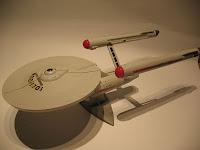I've been busy reading up on the blogs of my fellow modeller-bloggers and decided that adding a little background or history to a model can be a nice touch. The last two assignments for the Sprue Cutters Union also made me realize I rather like writing about something else for a change, instead of just reporting progress (or lack thereof :-\) on one or more models.
As a first, I decided to do the Enterprise-C, since I know it's history by heart. I used to be a die-hard "Trekkie" back in the "nineties". The interest has since faded with the discontinuation of the series, but after 35 years, who can blame the producers.
All ships named Enterprise
The Enterprise with designation NCC-1701-C is the fifth of it's name. Like any vessel in our own history, each has a class designation, usually named after the first ship with that design.
Here's a list of all its namesakes within the Star Trek universe.
(All models shown were made about 10-15 years ago.)
NCC-1701
Constitution class
This is the ship as it was seen in the original Star Trek series (from 1966 until 1969) and the first 3 movies (The motion picture - 1979, The wrath of Khan - 1982 and The search for Spock - 1984). It was destroyed at the end of the 3rd movie.
My model of this ship was a cut-away version, showing the interior of the saucer, drive section and one warp nacelle.
Constitution refit
Used in the movies 4 through 6 (The Voyage Home - 1986, The Final Frontier - 1989 and The Undiscovered Country - 1991), still with the crew of the original series.
I have an unassembled version of this model somewhere in the attic. It's just sprayed white. I'll probably finish it in one of the following months.
NCC-1701-B
Excelsior class
Used in the 7th movie (Generations - 1994) wherein it is badly damaged on it's maiden voyage, causing many of it's crew to go missing, presumed death. (Go watch the movie to see what really happened)
My model below.
NCC-1701-C
Ambassador class
This ship appears in only 1 episode of Star Trek : The Next Generation.
(More details at the end of this post)
I'm currently working on his model. The saucer was badly damaged, so I did an attempt at repairing it, but the damage will remain visible.
NCC-1701-D
Galaxy class
The flagship of the United Federation of Planets in Star Trek : The Next Generation, which was on TV from 1987 until 1994. Crash landed at the end of the 7th movie (Generations - 1994) rather spectacularly.
My first Star Trek model. The Aztec pattern took a looong time to finish, but I'm still happy with how it looks this early in my "modelling career".
Sovereign class
Used in movies 8 through 10 (First Contact - 1996, Insurrection - 1998 and Nemesis - 2002), still with the cast of The Next Generation.
My model :
NX-01
Shown in the prequel series "Enterprise", aired from 2001 to 2005.
I do not own a model of this ship, but I never felt the same connection with it as with the other series and ships.
The story of the Enterprise-C
The Enterprise-C is encountered in one of the episodes of Star Trek : The Next Generation. The crew of the Enterprise-D is happily flying around until they discover an anomaly. It turns out to be a rift in the space-time continuum (such an easy fix to explain time-travel episodes) and out comes the Enterprise-C. At this time, the current reality is shifted into an altered state, but only one crewmember is aware of this.
In the "normal" reality, all that is know of the fate of the Enterprise-C is that it was destroyed some 20 years ago, defending a Klingon outpost (Narrendra III, if you like details) from a Romulan attack. The ship is presumed destroyed with all hands, but it's heroic act becomes the basis for forging an alliance between the Federation and the Klingon Empire.
In the "alternate" reality, the explosion that should have destroyed the Enteprise-C creates a rift in time and space and hurls it 20 years into the future. This way, it never defended the outpost for longer than a few minutes, it's heroic act was never that big of a deal and the alliance never happened. In our "modified" reality, the Federation is therefore still at war with the Klingons.
After a lot of talking (man, these 1990's sitcoms had a lot of talking!) the crew decides to send the Enterprise-C back where it came from, effectively ordering them to their death, but sacrificing one ship and crew to save billions of people by restoring the timeline.
Note : I do not yet feel up to the challenge of producing a battle-damaged Enterprise, so the model I'll be portraying dates from 3 seconds before the attack :-).










































